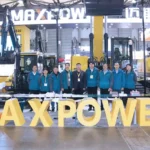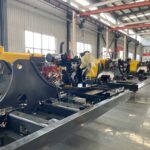Introduction
Bulldozers are powerful and versatile pieces of heavy construction equipment used for various earthmoving tasks like digging, pushing, carrying, lifting and grading soil, rocks or other building materials. They are an essential machine on construction sites as well as mining, forestry and landscaping projects.
As global construction activity continues to grow, particularly in developing countries undertaking major infrastructure projects, demand for heavy equipment like bulldozers is on the rise. This creates lucrative export opportunities for bulldozer manufacturers and dealers in mature markets looking to sell their inventory abroad.
In this blog post, we will cover everything you need to know about exporting used and new bulldozers for sale overseas.
Top Export Markets for Bulldozers

The top destinations importing bulldozers globally include:
- Asia Pacific – China, Japan, South Korea, India, Australia
- Middle East – Saudi Arabia, UAE, Qatar
- Africa – South Africa, Nigeria, Kenya, Ethiopia
- South America – Brazil, Colombia, Chile, Peru
- North America – Canada, Mexico
- Eastern Europe – Russia, Poland, Czech Republic
These markets have major construction and infrastructure projects underway with strong demand for heavy equipment. They also often lack sufficient domestic bulldozer production capacity.
The table below shows total global imports of bulldozers and angledozers over the past five years in millions of US dollars:
| Year | Bulldozer Imports (USD Millions) |
|---|---|
| 2019 | $8,912 |
| 2018 | $9,780 |
| 2017 | $7,216 |
| 2016 | $5,987 |
| 2015 | $7,124 |
(Source: UN Comtrade)
As you can see, there is a sizable multi-billion dollar global import market for bulldozers.
Used vs New Bulldozers for Export
When exporting bulldozers overseas, you can sell either used or brand new units:
Used Bulldozers
- Cheaper purchase price
- Can export older restored models
- Limited lifespan and higher maintenance
- Less training/support required
New Bulldozers
- Higher export sales value
- Covered by manufacturer warranties
- State-of-the-art designs and features
- Technical training/maintenance support
New bulldozers will bring higher profit margins but used and reconditioned units have lower upfront costs while still having decent demand abroad.
Top Bulldozer Manufacturers
The leading bulldozer manufacturers worldwide include:
- Caterpillar
- Komatsu
- John Deere
- Liebherr
- Hitachi
- Maxpower
- LiuGong
- Shantui
- Guangxi Liugong
You can contact dealers and export divisions from these brand name bulldozer makers to source units for export.
They build bulldozers in a wide range of sizes and configurations to suit different earthmoving applications.
Technical Bulldozer Specifications
When exporting bulldozers, key technical specifications you’ll need to provide to international buyers include:
- Machine weight/operating weight
- Engine power
- Blade capacity
- Travel speeds
- Fuel capacity
- Lifting capacity
- Dimensions
- Available attachments
Providing detailed technical specification sheets on the bulldozers allows overseas buyers to assess suitability for their projects.
Here is an example comparison technical data table for two model bulldozers from leading manufacturers:
| Specification | Caterpillar D6K2 XL | Komatsu D65EX-18 |
|---|---|---|
| Operating Weight | 18 tonnes | 19 tonnes |
| Net Power | 105 hp | 110 hp |
| Blade Capacity | 3.8 cu m | 2.13 cu m |
| Top Speed | 9.5 km/h | 5.6 km/h |
| Fuel Tank Capacity | 223 litres | 250 litres |
| Max Lift Height | 1 metre | 1 metre |
| Length x Width x Height | 5.79 x 2.5 x 3.14 metres | 5.73 x 2.88 x 3.04 metres |
This allows buyers to compare technical parameters across different bulldozer models.
Export Documentation
To export bulldozers overseas, you’ll need to prepare certain documentation which typically includes:
- Export declaration
- Bill of export
- Invoices
- Packing lists
- Proof of ownership/purchase
- Insurance certificate
- Customs forms
- Inspection certificates
Proper documentation is crucial for clearing bulldozers through customs at both export departure points as well as import arrival points.
You must itemize details like the exact number of bulldozer units, specifications, serial numbers, total values and weight along with exporter/importer information.
Shipping Logistics

Bulldozers are extremely heavy construction machines weighing anywhere from 10 to 100+ tonnes. Therefore, specialized shipping and logistics arrangements are vital for transporting them overseas.
Common shipping methods include:
RoRo Shipments
Roll-on/roll-off vessels allow bulldozers to be driven on and off the cargo ship on their own wheels without cranes. This convenient option minimizes handling but availability may be limited.
Containerized Transport
Large heavy-lift containers can accommodate dismantled bulldozers for protected shipping. More flexible but loading/unloading bulldozer parts takes time and cost.
Breakbulk
General cargo vessels can ship assembled bulldozers strapped to the deck when container/RoRo options are not available. Exposure to elements so protection recommended.
When booking bulldozer transport, consider special parameters like height/weight restrictions, permits, escorts, cargo insurance etc.
Conclusion:Bulldozers for Sale
Exporting bulldozers to meet overseas demand can be extremely lucrative for equipment dealers and manufacturers. New and used bulldozers for sale are imported by countries across Asia, the Middle East, Africa and more for construction and mining industry projects.
By sourcing inventory from top bulldozer brands like Caterpillar and Komatsu, preparing proper documentation and arranging suitable heavy lift shipping, exporters can capitalize on this multi-billion dollar global import market.
Attention to technical specifications, competitive pricing, export regulations and building relationships with international buyers will be key success factors.
There is tremendous room for growth as major developing regions continue investing in roads, buildings, energy and infrastructure driving heavy equipment imports.
FAQ
What are the most popular bulldozer models for export?
Some of the best-selling bulldozer models globally include the Caterpillar D6, D7 and D8 along with the Komatsu D65, D85 and D155. These medium to large dozers offer an optimal balance of size, power and versatility to suit a range of earthmoving applications.
What should CIF export pricing be for bulldozers?
CIF (Cost, Insurance & Freight) pricing for exported bulldozers can vary greatly depending on age, hours, specifications and shipping distance but a good rule of thumb is 30-50% off new US retail pricing for equivalently spec’d machines.
What special export financing options exist for overseas bulldozer projects?
Many export credit agencies and development banks like the US Exim Bank or World Bank offer financing support for international buyers purchasing American construction equipment for major infrastructure projects that meet domestic content requirements.
They provide credit guarantees or low-interest loans to qualified organizations undertaking projects like roadbuilding, mining, land development etc. Bulldozer exporters should research options for beneficial export financing packages through government and institutional programs.
What after-sales support is expected by overseas bulldozer buyers?
Proper technical guidance, training and maintenance support is critical for international bulldozer buyers unfamiliar with operating American-made heavy equipment. Exporters should have service plans for overseas customer assistance via remote diagnostics, authorized repair centers and qualified mobile tech dispatch. Warranty coverage, parts availability and rebuilder/buyback options also important.
Do language barriers create issues when exporting to emerging markets?
Absolutely – having multilingual sales and support staff capable of interfacing with global bulldozer buyers in their native languages minimizes confusion. Key languages like Spanish, Arabic, Russian, Chinese, Hindi go a long way rather than just English. Getting translations of manuals/documentation also advised. Understanding different business cultures critical too.







-150x150.webp)
